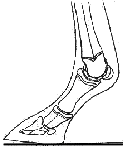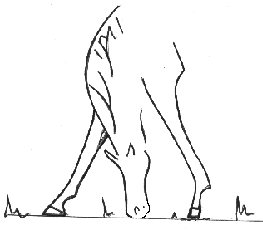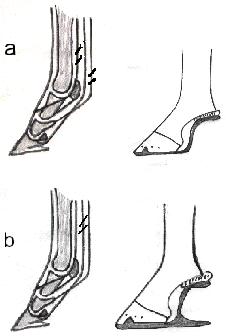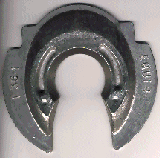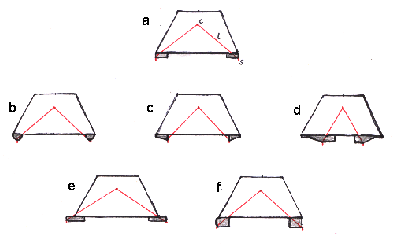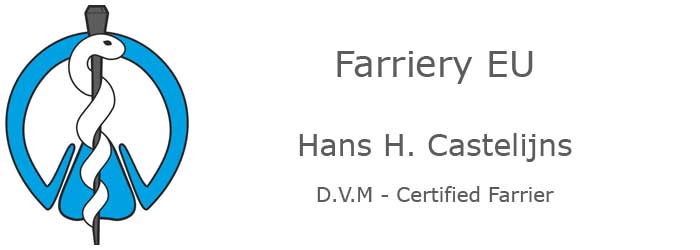 |
Orthopedic shoeing techniques in the prevention and treatment of tendon and articular pathologies |
||||||
Contents:I. INTRODUCTION |
||||||
Summary:A brief review of trimming and shoeing techniques and materials, useful in the prevention and therapy of tendon, ligament and articular pathology in the equine limb, is offered. Special attention is given to the application of the results of recent locomotion research and hoofcare material development. Keywords:Orthopaedic shoeing, flexor flaccidity, flexor contractures, tendon injuries, desmitis, angular limb deformities, navicular disease, degenerative joint disease. Abbreviations:DDFT: deep digital flexor tendon |
||||||
I. Introduction:Lameness and perhaps even more important, the prevention of lameness in horses has to be addressed by a close partnership between Vet and Farrier. For this often invoked partnership to work though, the left balance between the empirical craftsmanship of the farrier and the clinical know how of the Vet. has to be struck. For the equine practitioner a thorough familiarity with various trimming and shoeing techniques and materials is as important as his / her knowledge of surgical methods and instruments. Especially so in the light of the recent progress in, and multiplication of, both locomotion studies and hoofcare materials. |
||||||
II. Tendon and Suspensory Ligament InjuriesAre mostly affected and treated by changes in the sagittal plane of the hoof and digit, either by modifying the digital axis or through dorsal or palmar / palmar extensions. In the foal, were there are objective limits to the use of nailed on shoes, glue on shoes and highly adhesive polymers are extremely useful in the treatment of various developmental defects. Thus flexor flaccidity in the newborn can be treated with plantar extensions. (Fig. 1) |
||||||
|
||||||
|
Deep digital flexor tendon (DDFT) contractures, which lead to flexure deformity of the distal interphalangeal joint (DIPJ) often observed in the stage of rapid development around 2-6 months of age can benefit from dorsal extensions, in this last case it is often useful to initially raise the heels with a screwed on and easily adjustable wedge so as to interrupt the vicious cycle of contracture - pain - further contracture. (Fig. 2) |
||||||
|
||||||
Grassfoot (Fig.3) can be defined as an acquired flexor - suspensory asymmetry between the forelimbs of the foal, usually due to a relatively faster lengthening of the limbs then of the neck; the resulting monolateral clubfoot can be treated with the same techniques. |
||||||
|
||||||
In severe and refractionary cases which can be evaluated by the persistence of much faster growth at the heels (non-parallel growth rings, Fig.4) inferior check ligament desmotomy is indicated allowing then for more radical dorsal hoofwall reconstruction and extension and lowering of the heels. |
||||||
|
||||||
Superficial digital flexor tendon (SDFT) contractures usually observed at a later age (8 - 12 months) which lead to reduced extension of the fetlock joints (knuckling) can benefit from raised heels, which at this stage can usually be obtained with nailed on shoes, and superior check ligament desmotomy. In adult horses raising the heels, which by realigning a broken back digital axis distends the DDFT and increases the load on the SDFT and suspensory ligament (SL), can be obtained with wedge pads, wedge shoes, open or eggbar, the later made out of aluminium alloys so as to keep weight down. The heels can also be artificially reconstructed and raised with the use of methacrylate polymers. (Fig.5) |
||||||
|
||||||
Since DDFT lesions are certainly rarer then SDFT and SL lesions, the main use of these techniques is arguable for the prevention and treatment of navicular disease. The prevention of “flexor type” navicular disease requires a correct hoof - pastern alignment and easy breakover, in other words preventing or correcting the development of hoofs with long toes and underrun heels. Square - toe, rocker - toe, rolled - toe, setting the shoe back, eggbars and reverse shoeing all place the center of the shoe in better alignment with the center of the distal interphalangeal joint (DIPJ) (Fig.6). |
||||||
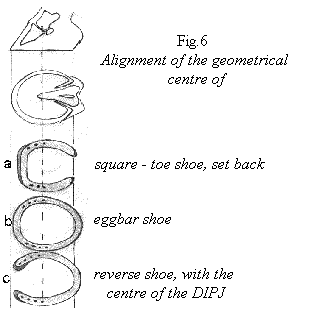 |
||||||
Causing other parts of the hoof besides the wall to participate in weight bearing (as seems to be the case in feral horses [1]) promotes better hoof wall growth at the site of crushed and underrun heels. Heart bar shoes, but also the use of fast setting silicones or polyurethane's (Fig.7), which are less traumatic to the overlying digital cushion and navicular area, are examples. |
||||||
|
||||||
Lesions to the inferior check ligament benefit from a shoe with good palmar support and easy breakover as is the case with DDFT injuries, if there is good phalangeal alignment reverse shoeing is often beneficial as it keeps the heels from sinking to far into deep ground, and allows for the easiest breakover possible. Injuries of the SDFT should certainly not be treated by raising the heels and could even benefit from a shoe with a wide web at the toe and narrow heels during recovery. [2] Traumatic injury with total or partial severance of one or more elements of the suspensory apparatus can be treated with a fetlock brace which needs an additional palmar / plantar extension if the DDFT is one of the affected structures (Fig.8) Finally digital extensor tendon lesions and rupture can benefit from dorsal extension during rehabilitation. |
||||||
|
||||||
III. Arthritis - Desmitis and Degenerative Joint Disease (DJD)in the equine digit are frequently encountered in equine practice, perhaps all to frequently, which proves the need for greater prevention. Since the lower limb joints in the horse have evolved to function in the sagittal plane, faulty conformation, like angular limb deviations and rotations predispose to articular and collateral ligament pathology. Prevention should therefore start at the breeding farm on foals in their first 6 months of life when the growth plates are highly active. Hoofcare in foals has benefited from the introduction of latero - medial extension glue on shoes (Fig.9) which can be applied in the early stages of life when the hoofcapsule is to small to bear effective nailing. Severe angular limb deformities can benefit from a combination of orthopaedic shoeing and surgery. (eg. periostal elevation) |
||||||
|
||||||
In the adult horse latero - medial and rotational stress on the lower limb joints and collateral ligaments is not only increased in the case of conformational defects but also through faulty trimming and indeed by work in tight circles and on irregular ground. Recent research has not only confirmed the importance of adequate latero - medial balance of the foot but also lead to the development of an interesting radiological protocol for trimming in the frontal plane. This can be an important tool for the equine vet in assisting the farrier, particularly when confronted with conformation defects like angular deviations and or rotations. It is interesting to note that in a clinical trial over 70% of chronically grade I-II lame horses which responded to distal palmar digital anaesthesia improved to soundness with the sole application of the radiologically controlled trimming procedure. So called full rolling motion shoes diminish the articular constraints in all directions by shortening the moment arm from the DIPJ center to the lower outer rim of the shoe where latero - medial breakover takes place. (Fig.10, 11) |
||||||
|
||||||
The use of these shoes has given excellent results both in clinical trials and in the, albeit limited practice of the author, in those horses diagnosed as suffering from (articular) navicular disease, DJD of the DIPJ or "palmar hoof pain" The damage from shock and high frequency vibrations generated on impact of the hoof with the ground and transmitted to the limb probably plays a large role in articular pathology of the equine athlete specially when asked to perform on compact surfaces (eg. standardbreds - endurance horses). The phatological sequence probably originates, as in human "white finger syndrome", with high energy vibration induced vasoconstriction resulting in local ischemia. Therefore a lot of thought and effort has been put into shock absorbing shoeing systems; today there is a large selection of shock absorbing pads and some polyurethane and rubber covered shoes on the market. Aluminium itself is already much more shock absorbing then steel. Filling the space between the pad and the sole - bars - frog with fast curing elastic polymers is an additional option. The use of these materials does have some practical drawbacks such as: an increase of total thickness of the shoeing system (and therefore of the moment - arm), an increase in weight (more effort and more joint flexion during locomotion) and specially with the use of pads: higher stress on the nail - hoofwall junction as the distance between the nail and the rivet placement on the hoofwall varies slightly during each stride due to the compression - expansion of the pad. A comparative study of different shock absorbing shoeing systems in standard conditions shows that the more efficient systems preclude the nail heads from touching the ground as they probably transmit some energy directly to the hoofwall "bypassing" the pad. The hoofwall itself is nature's best answer to the need for vibration damping and shock absorption. Water content and hoofshape are correlated with each other and with hoof capsule elasticity, indicating the importance of proper maintenance. Glue on shoes preserve the hoof 's elastic movement better then shoes fixed with nails since the later tend to block hoofwall expansion through their union to the rigid shoe, specially when placed further back towards the heels. There is certainly a need for a long term statistical study of the incidence of different locomotion system pathology's in populations of horses shod with shock absorbing shoeing systems versus normally shod horses to be able to draw definite conclusions as to the real benefits. It seems that lately some members of the horse insurance industry have expressed interest in acquiring such data. |
||||||
Conclusion:Farriery is in full progress, thanks to new technologies, materials and studies offering exciting opportunities with the prevention and treatment of lameness in horses, equine practitioners should keep up to date in these developments so as to advise farriers and owners appropriately, farriers should become willing to incorporate different materials and methods in their practice if these are of benefit to the horse. |
||||||
References:OVNICEK, G.; ERFLE, J.B.; PETER, D.F.; Wild Horse Hoof Patterns Offer a Formula for Preventing and Treating Lameness; AAEP proceedings 1995 Vol.41. DENOIX, J.M.; Bases biomecaniques du traitement orthopédique des tendinites. 9 ième Congres Maréchaux et Vétérinaires, 31-01-1997, Cluses - F. CAUDRON, J.; Approche orthopédique des affections osteo - articulaires dégénératives de l'extrémité digitale du cheval. Thèse présentée en vue de l'obtention du grade de Docteur en Sciences Vétérinaires. Année Académique 1997 - 1998; Université de Liège Faculté de Médecine Vétérinaire. CAUDRON, J.; MEISEN, M.; GRÜLKE, S.; VANSCHEPDAEL, P.; SERTEYN, D.; Clinical and radiographic assessment of corrective trimming in lame horses; Journal of Equine Veterinary Science, 1997, 17 (7): pp 375 - 379. SERTEYN, D.; VANSCHEPDAEL, P.; CAUDRON, J.; MEISEN, M.; LALOT, P.; GRÜLKE, S.;STAQUEZ, S.; Evaluation clinique de la ferrure orthopédique Equi + lors de pathologies de l'articulation interphalangienne distale, Pratique Vétérinaire Equine, 1995, 27 (2); pp 105- 110. RŸKENHUIZEN, A.B.M.; NÉMETH, F.; DIK, K.J.; GOEDGEBUURE, S.A.; VAN DENBROM, W.E.; The effect of artificial occlusion of the ramus navicularis and its branching arteries on the navicular bone in horses: An experimental study; Equine Vet. J. (1989)21 (6) pag. 425 - 430. BENOIT, P.;BARREY, E.; REGNAULT, J.C.; BROCHET, J.L.; Comparison of the Damping Effect of Different Shoeing by the Measurement of Hoof Acceleration.; Acta Anat. 1993; 146: pag. 109 - 113. PREUSCHOFT, D.; Neue wege der hufbehandlung. Dallmer, H.; Neiheimer Druckerei Stach. Kg. 2 auflage, 1993. YXKLINTEN, U.; Personal communication (1999). |
||||||
Hans Castelijns
D.V.M - Certified Farrier
